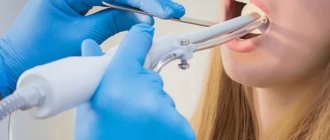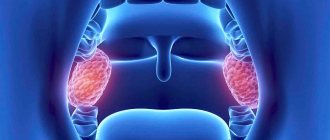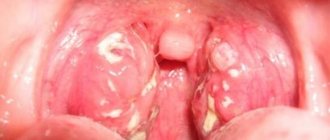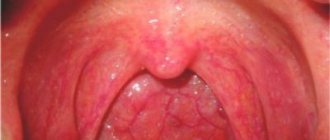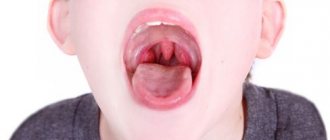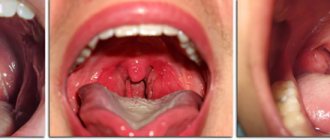What is the reason for this difference in approaches in the practice of Russian doctors and their colleagues from other countries?
First of all, the criteria on the basis of which the diagnosis of chronic tonsillitis is made are very different. In Russian medical practice, this diagnosis is often made based on an examination of the throat, even without assessing the patient’s history. In the practice of doctors from European countries, Japan, and the USA, such a diagnosis is rarely made, and based on a number of signs.
Patients who have been diagnosed with this can often hear about a “locus of chronic infection”, the risk of developing other diseases due to the fact that dangerous bacteria spread from the palatine tonsils to other organs and systems. Today this medical concept is outdated. Numerous studies and meta-studies have shown that only one disease has a risk of spreading beyond the tonsils - tonsillitis or, in scientific terms, “streptococcal acute tonsillitis”.
Sore throat is a disease caused by certain bacteria that are easily transmitted from person to person. If a patient suffers from tonsillitis more than 2-3 times a year for several years, the tonsils need to be removed. This is the only measure that, from the standpoint of modern science, can help the patient in this situation and negate the risks of developing other diseases.
Rinsing the tonsils does not reduce the risk of developing tonsillitis.
Bad breath in a child
In children, this problem is less common than in adults, because, as a rule, the average child has not yet developed chronic diseases of the gastrointestinal tract, and not all teeth have erupted. But what to do if you notice your child has bad breath? The reasons here are the same as in adults: in this way the body signals problems in the body. This means that there is a failure somewhere and a full examination needs to be carried out. In children of preschool and school age, adenoids may be a predisposing factor. The scheme is simple: adenoid growths block the path of air / breathing from the nose is replaced by the mouth / the mucous membrane dries out / saliva becomes scarce and bacteria multiply, giving rise to repulsive breathing. What if it’s just a baby? Many mothers are interested in what could be the cause of the problem if the child is one year old. Bad breath at this age can already appear due to the accumulation of plaque on the teeth (the norm is 8 by the age of one), the presence of worms, and the abuse of carbohydrate foods (cookies, sweets).
Important! You should be wary if you smell acetone from your mouth. You should contact an endocrinologist to be examined for diabetes and other electrolyte disorders.
Why then wash the tonsils?
Usually the reason for washing is the so-called “plugs” or tonsillitis. Among patients and, unfortunately, often among doctors, there is a belief that these “traffic jams” are manifestations of a chronic infection. Sometimes you can hear the term “purulent plugs”. This description is incorrect. Indeed, in the lacunae (pores) of the palatine tonsils, food debris, calcium salts, dead and obsolete cells of the palatine tonsils and bacteria that normally live in the oral cavity sometimes accumulate. Together they form a white conglomerate, usually dense. Tonsilloliths themselves are not a sign of any disease. In the event that they physically interfere with the patient, as a rule, proper independent care of the oral cavity and teeth is sufficient.
The root of the problem is microorganisms
Why is bad breath so persistent and appears again and again? To deal with the problem, you need to understand the mechanism of its occurrence as a whole. As you know, the mouth is a “home” for many bacteria, microorganisms, and fungi. Naturally, like all living organisms, they feed and excrete waste products. The more plaque there is on the teeth, the more comfortable the bacteria feel, because their preferred environment is oxygen-free, and just such conditions are created under the layer of plaque. Microorganisms produce sulfur compounds, which have a pungent odor and feel repulsive. It is noteworthy that even if a person brushes his teeth thoroughly, in some cases (for example, progressive periodontal disease), deep periodontal pockets cannot be cleaned out on their own, and they become a source of foul odor. The same applies to plugs with purulent tonsillitis, when white lumps of pus accumulate in the lacunae of the tonsils.
What to do if your throat constantly hurts? Is this an infection?
No, persistent sore throat is most often caused by non-infectious causes. The most common cause is acid from the stomach entering the back of the throat through the esophagus. This condition is medically called gastroesophageal, or extraesophageal, reflux. This is a very common illness that can occur without abdominal pain or heartburn. If heartburn occurs constantly and your throat often hurts, then the connection between these events is obvious and you need to deal with this particular problem, and not try to cure your throat.
Prevention is everything!
If you think that you have overcome bad breath, the treatment is over and you can relax - you are mistaken. It can come back very quickly, so listen to simple recommendations.
Helpful tips for fresh breath:
- Drink more water.
Sufficient intake of water into the body ensures a high dissolving ability of saliva and washing away germs. - Consume more solid fruits and vegetables.
Fruits and vegetables serve as a kind of “grater” for plaque, removing it from the surface of the teeth. Less plaque - less odor! - Stimulate salivation.
This can be achieved by chewing something. Not necessarily chewing gum. Saliva production increases when chewing certain seeds and fruits with essential oils, such as cloves, parsley, mint.
In conclusion, we would like to remind you that in ancient times, based on the smell from the mouth, people could form an idea about a person, including their character traits. Subconsciously, this happens even today. There is only one conclusion - it’s better to take care of your health, this is reasonable from all points of view, as you have already seen.
Diagnostics
Traffic jams in themselves are not a disease, but only its consequence.
It is necessary to determine the causes and treatment of the disease that provoked the formation of a plug in the tonsils. You can independently detect a blockage in the tonsils by examining your own throat and comparing it with photographs showing what the blockages look like.
An otolaryngologist only needs to look at the patient's throat to make a diagnosis.
The doctor will also interview the patient, paying attention to symptoms. Additionally, an ultrasound and a throat smear may be required to determine the nature of stones in the lacunae
The problem of congestion in the tonsils in children is solved by a pediatrician - a pediatrician or a pediatric otolaryngologist. After an examination, the doctor prescribes treatment that will help both get rid of the tonsil blockage and prevent their reoccurrence.
For an experienced doctor, identifying tonsillitis is not particularly difficult. The disease is accompanied by redness and swelling of the tonsils, the presence of plugs with an unpleasant odor in their lacunae, and enlarged lymph nodes located on the neck near the ears.
But, since the causative agent of pathology can be a variety of microorganisms, it is important to determine which one among them caused the disease. After identifying the pathogen, it becomes clear to the doctor which medicine is best to use to combat a particular microorganism
Therefore, if tonsillitis appears, you should definitely consult a doctor and undergo all the necessary tests. A blood test will indicate the presence of the disease by the following indicators:
- Increased level of leukocytes (up to 20*109/l or more).
- Increase in ESR (up to 40-50 mm/hour).
- A large number of immature leukocytes.
How can a doctor help?
Treatment of tonsillitis must be carried out comprehensively. Before prescribing medications, the ENT doctor will remove plugs from the tonsils using a blunt spatula or a special irrigator. This device is intended for washing the affected lacunae with a stream of medicinal solution.
After this, the patient may be prescribed the following treatment:
- Physiotherapy, phonophoresis.
- Rinse with medicinal solutions.
- Antifungal or antibacterial drugs.
If conservative therapy methods do not help, and the inflammation begins to spread to surrounding tissues, the patient is prescribed an emergency surgical operation called tonsillectomy. The tonsil removal procedure is performed under local or general anesthesia.
After the operation, the patient is prescribed a special diet that excludes foods that irritate the operated tissues and slow down their healing process. Also in the postoperative period you should avoid alcohol, taking hot baths and playing sports.
Categories
AllergistAnesthesiologist-resuscitatorVenereologistGastroenterologistHematologistGeneticGynecologistHomeopathDermatologistPediatric gynecologistPediatric neurologistPediatric urologistPediatric surgeonPediatric endocrinologistNutrologistImmunologistInfectious disease specialistCardiologistCosmetologistSpeech therapistElorologistMammologistMedical lawyerNarcologistNeurologistNeurosurgeon NephrologistNutriciologistOncologistOncourologistOrthopedist-traumatologistOphthalmologistPediatricianPlastic surgeonProctologistPsychiatristPsychologistPulmonologistRheumatologistRadiologistSexologist-AndrologistDentistTherapistTrichologistUrologistPharmacistPhytotherapistPhlebologistSurgeonEndocrinologist
Professional methods: removing plugs and rinsing lacunae
Having figured out how to get rid of the smell of unhealthy tonsils on your own, you should consider the methods offered by otolaryngologists.
First of all, in case of chronic tonsillitis, lavage of lacunae is indicated. This procedure is carried out using a special syringe with a curved tip, or a vacuum device for cleaning the tonsils. The essence of the procedure is to irrigate the cavities in the tonsils with an antiseptic solution. Most often, doctors use a solution of furatsilin.
Note! Rinsing the lacunae will not only help remove the odor from the tonsils, but also get rid of chronic tonsillitis. Plugs in gaps must be removed. They are an accumulation of waste products of pathogenic bacteria and cause a putrid odor from the oral cavity
To remove plugs, doctors use the same syringe with a curved tip, as it is convenient for them to break up the solid contents of the lacunae. A more gentle method is vacuum cleaning. A vacuum nozzle is applied to the lacuna, which literally pulls out the plugs. Then the depressions are irrigated with an antiseptic solution, and at the end the doctor lubricates the tonsils with Lugol
They are an accumulation of waste products of pathogenic bacteria and cause a putrid odor from the oral cavity. To remove plugs, doctors use the same syringe with a curved tip, as it is convenient for them to break up the solid contents of the lacunae. A more gentle method is vacuum cleaning. A vacuum nozzle is applied to the lacuna, which literally pulls out the plugs. Then the depressions are irrigated with an antiseptic solution, and at the end the doctor lubricates the tonsils with Lugol
Plugs in gaps must be removed. They are an accumulation of waste products of pathogenic bacteria and cause a putrid odor from the oral cavity. To remove plugs, doctors use the same syringe with a curved tip, as it is convenient for them to break up the solid contents of the lacunae. A more gentle method is vacuum cleaning. A vacuum nozzle is applied to the lacuna, which literally pulls out the plugs. Then the depressions are irrigated with an antiseptic solution, and at the end the doctor lubricates the tonsils with Lugol.
Washing lacunae at home
A syringe with a curved tip can be easily purchased at any pharmacy, so rinsing the lacunae can be done at home. True, at home it is forbidden to insert the tip into the lacuna itself, otherwise there is a risk of injury to it, which will only aggravate the problem.
It is necessary to draw a solution of furatsilin into the syringe, place the tip opposite the recesses, and irrigate the lacunae with the solution, spitting it as it flows into the mouth.
At home, you can also use an irrigator with a special attachment. The sequence of action is the same: the device is filled with an antiseptic solution, the tip is brought as close as possible to the recesses of the tonsils, and then irrigated with the medicine.
At the end of the procedure, the tonsils should also be lubricated with Lugol - this will help prolong the effect of rinsing and prevent the re-formation of plaque.

